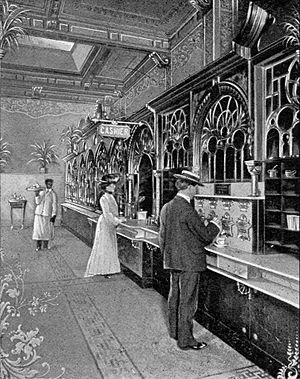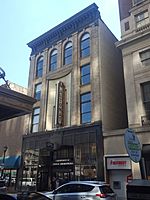- This page was last modified on 15 April 2025, at 02:15. Suggest an edit.
Horn & Hardart facts for kids

First Automat, 818-820 Chestnut Street, Philadelphia, (1904 postcard)
|
|
| Privately held company | |
| Industry | Restaurants |
| Founded | 1888 |
|
Key people
|
Joseph Horn, Frank Hardart |
| Revenue | USD |
| USD | |
Horn & Hardart was a food services company in the United States noted for operating the first food service automats in Baltimore, Philadelphia and New York City.
Philadelphia's Joseph Horn (1861–1941) and German-born, New Orleans-raised Frank Hardart (1850–1918) opened their first restaurant together in Philadelphia, on December 22, 1888. The small, 11-by-17-foot (3.4 m × 5.2 m) lunchroom at 39 South Thirteenth Street had no tables, only a counter with 15 stools. The location had housed the print shop of Dunlap & Claypoole, printers to the American Congress and George Washington.
By introducing Philadelphia to New Orleans-style coffee (blended with chicory), which Hardart promoted as their "gilt-edge" brew, they made their tiny luncheonette a local attraction. News of the coffee spread, and the business flourished. They incorporated as the Horn & Hardart Baking Company in 1898.
Contents
History
Inspired by Max Sielaff's Automat Restaurants in Berlin, they were among the first 47 restaurants, and the first non-Europeans, to receive patented vending machines from Max Sielaff's Automat GmbH factory in Berlin, the creators of the first chocolate bar vending machine for Ludwig Stollwerck.
The first automat in the U.S. was opened June 12, 1902, at 818 Chestnut St. in Philadelphia by Horn & Hardart. The first New York Automat opened in Times Square July 2, 1912. Later that week, another opened at Broadway and E 14th St, near Union Square.
In 1924, Horn & Hardart opened retail stores to sell prepackaged automat favorites. Using the advertising slogan, "Less Work for Mother," the company popularized the notion of easily served "take-out" food as an equivalent to "home-cooked" meals.
The Horn & Hardart Automats were particularly popular during the Depression era, when their macaroni and cheese, baked beans, and creamed spinach were staple offerings. In the 1930s, union conflicts resulted in vandalism, as noted by Christopher Gray in The New York Times:
In 1932 the police blamed members of the glaziers union for vandalism against 24 Horn & Hardart and Bickford's restaurants in Manhattan, including the one at 488 Eighth Avenue. Witnesses said that a passenger in a car driving by used a slingshot to damage and even break the plate glass show windows. Glaziers union representatives had complained about nonunion employees installing glass at the restaurants.
By the time of Horn's death in 1941, the business had 157 retail shops and restaurants in the Baltimore, Philadelphia, and New York areas, and served 500,000 patrons a day. During the 1940s and the 1950s, more than 50 New York Horn & Hardart restaurants served 350,000 customers a day.
In 1953, the company split into two independent corporations: the New York company was named the Horn & Hardart Company, while the Philadelphia company was named the Horn & Hardart Baking Company. New York was traded on the American Stock Exchange, and Philadelphia was traded on the Philadelphia Stock Exchange.
Operation
In their heyday, Horn & Hardart establishments were popular, busy eateries. Their automats featured prepared foods behind small coin- and token-operated glass windows, beginning with buns, beans, fish cakes, and coffee. As late as the 1950s one could enjoy a large, if somewhat plain, meal for under $1.00. Each stack of glass-doored dispensers had a metal conveyor that could be rotated by the staff on the other side of the vending wall while they refilled each dispenser in the stack with a fresh item. Each dispenser had a slot for coins or tokens up to 75¢ for more expensive items, which were purchased from a cashier. A knob was rotated to allow the glass door to be raised and locked in position for easy removal of the food. Dispensers were cooled as appropriate.
Eventually the chain served lunch and dinner entrees, such as beef stew and Salisbury steak with mashed potatoes. The self-service restaurants operated for nearly a century, from 1902 to 1991.
Carolyn Hughes Crowley described the appeal of the Automats:
In huge rectangular halls filled with shiny, lacquered tables, women with rubber tips on their fingers — "nickel throwers," as they became known — in glass booths gave customers the five-cent pieces required to operate the dispensers. After depositing the appropriate amount the compartment opened to present the desired food to the customer through a small glass. Diners picked up hot foods at buffet-style steam tables.
The word "automat" comes from the Greek automatos, meaning "self-acting." Still, the Automats were heavily staffed. As a customer removed a compartment's contents, a worker quickly slipped another sandwich, salad, piece of pie or coffee cake into the vacated chamber.
Promotions
The Horn and Hardart Children's Hour
Radio program
Beginning in 1927, Horn & Hardart sponsored a radio program, The Horn and Hardart Children's Hour, a variety show with a cast of children, including some who as adults became well-known performers (such as Bernadette Peters and Frankie Avalon). The program was broadcast first on WCAU Radio in Philadelphia, hosted by Stan Lee Broza. It was broadcast on NBC Radio in New York during the 1940s and 1950s. The original New York host was Paul Douglas, succeeded by Ralph Edwards and finally Ed Herlihy.
Television program
The television premiere of The Horn & Hardart Children's Hour appeared on WCAU-TV in Philadelphia in 1948, succeeded by WNBT in New York in 1949, telecast on Sunday mornings. Stan Lee Broza hosted in Philadelphia, and Ed Herlihy in New York.
Decline

Automat at 104 West 57th Street near Sixth Avenue showing areas for beverages and pies at right of dining area
The restaurant chain remained popular into the 1960s, featuring not only automats but sit-down waitress service restaurants, cafeterias, and bakery shops. In the late 1960s, consultants attempted to develop automats with interior decoration relevant to surrounding neighborhoods; thus, the Automat on 14th Street was decorated with psychedelic posters. The eateries began to close with the rise of fast-food restaurants, which offered fare over the counter with normal cash transactions.
By the mid-1970s Burger King franchises replaced the automats at some locations. Horn & Hardart further expanded its fast food operations in 1981, with its acquisition of the Bojangles' Famous Chicken n' Biscuits restaurants, which it sold to a California investment company in 1990 for $20 million.
In 1979, Horn & Hardart agreed to buy the Royal Inn in Las Vegas for $7.4 million. By late 1980, the sale had been completed, and the property was rebranded as the Royal Americana Hotel, with a New York theme. A $3.5 million renovation increased the room count to 300. By 1982 though, the hotel was experiencing substantial losses, and Horn & Hardart decided to close it. They reportedly agreed that December to sell the property to an investment group for $15.4 million.
The last New York Horn & Hardart Automat (on the southeast corner of 42nd Street and Third Avenue) closed in April 1991. Horn & Hardart continued to own a catalog division; it renamed itself Hanover Direct in 1993. That year the company bought Gump's; it sold it to an investment group in 2005. Hanover Direct purchased International Male in 1987 when founder Gene Burkard retired.
Revivals
In 1987, Horn & Hardart opened two 1950s themed Dine-O-Mat restaurants in New York. They closed less than two years later.
In the early 1990s, two entrepreneurs bought the Philadelphia company (Horn & Hardart Baking Co.) out of bankruptcy. While they did not open any restaurants, they reproduced a dozen of the most famous food items, including macaroni and cheese, Harvard beets, tapioca pudding, and cucumber salad. The food was packed fresh, refrigerated, and sold in supermarkets throughout Philadelphia and New Jersey. The food was still available up until 2002.
The Horn & Hardart name was used for a now-dormant chain of coffee shops in Pennsylvania and New Jersey. The Horn & Hardart Coffee Co. closed its last coffee shop in 2005.
As of 2016, the Horn & Hardart – Bakery Cafe is the name of a coffee shop in Philadelphia, Pennsylvania.
The assets of the company were purchased in 2015 as Horn & Hardart Coffee. They recreated the original East Coast City Roast and branded coffee was offered as of 2016 on their website. They also offered a subscription service called The Automat Club.
A company called Horn & Hardart Brands had as of 2018 a website, with a 2014 copyright, offering coffee online and at food stores in the Philadelphia area.
In popular culture
Literature
- In Paul Auster's 2017 novel 4 3 2 1, Ferguson visits the restaurant, which is described as a place of "twentieth-century American efficiency in its craziest, most delightful incarnation".
Museum exhibits
- On June 22, 2012, the New York Public Library opened an exhibition on June 22, 2012, titled "Lunch Hour NYC". The exhibition "looks back at more than a century of New York lunches, when the city's early power brokers invented the 'power lunch' ..... and visitors with guidebooks thronged Times Square to eat lunch at the Automat." Among many educational and entertaining items is a fully restored wall of Automat windows. The exhibit was scheduled to run until February 17, 2013.
- The Smithsonian's National Museum of American History previously had displayed in its cafe an ornate 35-foot Automat section, complete with mirrors, marble and marquetry, from Philadelphia's 1902 Horn & Hardart although this exhibit has since been removed. In 2006 Paul and Tom Hardart donated the business records for the Horn and Hardart chain of restaurants and retail stores to the Smithsonian Archives; the records include annual reports, business correspondence, operating manuals, photographs, sales materials, and printed materials such as employee newsletters and clippings.
Music
- Concerto for Horn and Hardart is a classical music parody written by Peter Schickele, one of many which he attributes to the fictional composer P.D.Q. Bach.
Stage productions
- In the song "Colored Spade" from the musical Hair (1967), the character Hud (a militant African-American) satirically assigns to himself various racial stereotypes including "Table cleaner at Horn & Hardart".
- The original Broadway set for the musical The Producers (2001) incorporated some of the Automat.
Television
- Jack Benny held a promotional black tie party to launch his television show, The Jack Benny Program, on October 29, 1950, at the New York City Automat. Playing on his reputation as a cheapskate, Benny greeted his guests at the door and handed each one a roll of nickels so they could get what they wanted to eat.
Film
- That Touch Of Mink-(1962)Cary Grant, Doris Day-Gig Young visits NYC Automat and gets slapped when window opens by employee Audrey Meadows!
- The Automat-2021 documentary about the popular NYC restaurants featuring Mel Brooks, Carl Reiner, Ruth Bader Ginsberg.





